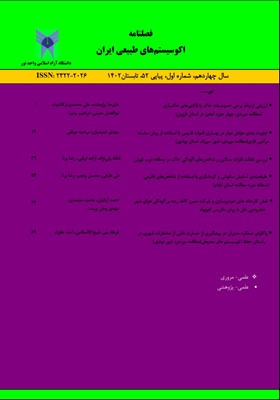طبقهبندی آسایش سکونتی و گردشگری با استفاده از شاخصهای اقلیمی(منطقه مورد مطالعه استان ایلام)
محورهای موضوعی : برنامه ریزی شهری
علی عارفی
1
*
,
محسن رنجبر
2
,
رضا برنا
3
![]()
1 - گروه آموزشی جغرافیا دانشکده علوم انسانی ،دانشگاه آزاد اسلامی واحد علوم تحقیقات تهران ،ایران
2 - دانشیار گروه آب و هواشناسی (اقلیم شناسی)، دانشکده ادبیات وعلوم انسانی و علوم اجتماعی، دانشگاه آزاد اسلامی، واحد علوم و تحقیقات
3 - دانشیار گروه جغرافیا، واحد اهواز، دانشگاه آزاد اسلامی، اهواز، ایران
کلید واژه: استان ایلام, آسایش سکونتی و گردشگری, بارش و دما, شاخصهای اقلیمی,
چکیده مقاله :
شناسایی مناطق مستعد آسایش سکونتی و گردشگری بر مبنای پارامترهای اقلیمی یکی از موضوعات پر کاربرد پژوهشگران اقلیم، جغرافیا و گردشگری است. به منظور شناسایی مناطق مستعد آسایش سکونتی و گردشگری باید مشخص شود که هر منطقه بر اساس تغییرات اقلیمی در چه طبقه ای از آسایش قرار می گیرد. با توجه به اهمیت موضوع، هدف از تحقیق حاضر طبقه بندی آسایش سکونتی و گردشگری با استفاده از شاخص های اقلیمی در استان ایلام است. ابتدا با استفاده از داده های اقلیمی بارش، دما، رطوبت نسبی و سرعت از شش ایستگاه سینوپتیک، به تحلیل شاخص های آماری توصیفی پرداخته شد. سپس با استفاده از شاخص های اقلیمی بیکر، دمای موثر و توزیع احتمالاتی، برای هر ماه درجه آسایش اقلیمی مشخص شد. این تحقیق از نظر قلمرو جغرافیایی به تحلیل پیامدهای تغییرات دما و بارش بر آسایش اقلیمی در استان ایلام میپردازد. نتایج برآیند شاخص های اقلیمی بیکر، دمای موثر و توزیع احتمالاتی نشان داد که ماه های فروردین، اردیبهشت، مهر، آبان و اسفند مستعد آسایش اقلیمی هستند. طبق نتایج، شهرهای دره شهر و لومار در ماههای گذار از گرما به سرما (مهر و آبان) و سرما به گرما (فروردین و اردیبهشت) بیشترین پتانسیل آسایش اقلیمی را داشته باشند. به طور کلی در فصل بهار و پاییز شهرهای شمالی و شرقی استان ایلام از آسایش اقلیمی بالاتری برخوردارند؛ در عوض در فصل زمستان شهرهای جنوبی و مرزی (مهران و دهلران) از آسایش اقلیمی مناسبی برخوردارند.
Identifying areas prone to residential comfort and tourism based on climatic parameters is one of the most used topics for climate, geography and tourism researchers. Considering the importance of the topic, the current study aimed to classify the climatic and tourism comfort using climatic indicators in Ilam province. First, using climatic data of rainfall, temperature, relative humidity and speed from six synoptic stations, descriptive statistics were analyzed. The statistical period of the study case was 30 years (water year 2010-2018 to 2019-2019). Next, using Baker's climatic indices, effective temperature and probability distribution, the degree of climatic comfort was determined for each month. This research analyzed the consequences of changes in temperature and precipitation on the climatic comfort of Ilam province in terms of geographical territory. The results of Baker's climatic indices, effective temperature and probability distribution showed that the months of April, May, October, November and March are prone to climatic comfort. According to the results, the cities of Darreh Shahr and Lomar have the greatest potential for climatic comfort in the months of transition from heat to cold (October and November) and cold to heat (April and May). In general, the northern and eastern cities of Ilam province have higher climatic comfort in spring and autumn. On the other hand, in winter season, the southern and border cities (Mehran and Dehloran) have a comfortable climate.
Zoghi, M., Ehsani, A.H., Sadat, M., javad Amiri, M. & Karimi, S. (2017). Optimization solar site selection by fuzzy logic model and weighted linear combination method in arid and semi-arid region: A case study Isfahan-IRAN. Renewable and Sustainable Energy Reviews, 68, pp 986-996.
_||_
